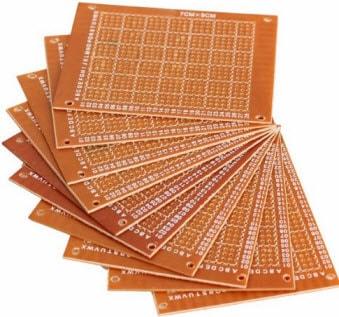Subscribe to get the latest news and updates. No span, we promise.



While choosing the right Printed Circuit Board (PCB) material for a high frequency application, you are required usually to tradeoff between performance and price. Two main questions that are crucial while selecting a PCB material are:
This post will help you choose the right PCB material for high frequency applications: What Materials are typically used in High Frequency PCB Assembly? The following table shows the materials used for high frequency PCB assembly, their ease of circuit fabrication, and electrical performance:
| Material | Ease of Circuit Fabrication | Electrical Performance |
| High Performance FR-4 | Easy | Poor |
| Ceramic-filled Hydrocarbon with woven glass | Easy | Good |
| Ceramic-filled Hydrocarbon | Difficult | Good |
| Ceramic-filled PTFE with woven glass | Moderate | Good |
| Ceramic-filled PTFE | Moderate | Excellent |
| PTFE with woven glass | Difficult | Good |
| PTFE with micro glass fiber | Difficult | Excellent |
Choosing Materials Based On Circuit Fabrication Issues:
Various mechanical processes such as plated-through-hole (PTH) preparation, drilling, multilayer lamination, and assembly, are performed during high-frequency PCB fabrication. The drilling process is used for creating clean holes, which are metalized to form electrical connections. There are several challenges involved in fabricating multilayer PCBs. One of the major challenges is that dissimilar materials are being joined together. The properties of these dissimilar materials complicate the PTH preparation and drilling processes. Furthermore, a disparity between material properties, such as coefficient of thermal expansion (CTE), can lead to consistency problems when the circuit is stressed thermally during assembly. The following table shows the CTE values of materials that are used in high frequency PCBs:
| Material | CTE (ppm/°C) |
| PTFE with micro glass fiber | 220 |
| PTFE with woven glass | 200 |
| High Performance FR-4 | 50 |
| Ceramic-filled PTFE with woven glass | 50 |
| Ceramic-filled Hydrocarbon with woven glass | 35 |
| Ceramic-filled PTFE | 25 |
| Ceramic-filled Hydrocarbon | 20 |
The main objective of the material selection process for a multilayer PCB, is finding a right combination of circuit materials. The combination should allow practical fabrication processing and meet end-user requirements.
The above information will help you in choosing the right PCB material for high frequency applications. If you still have doubts, you can get in touch with professionals having expertise in designing PCBs for high frequency applications.The main objective of the material selection process for a multilayer PCB, is finding a right combination of circuit materials. The combination should allow practical fabrication processing and meet end-user requirements.